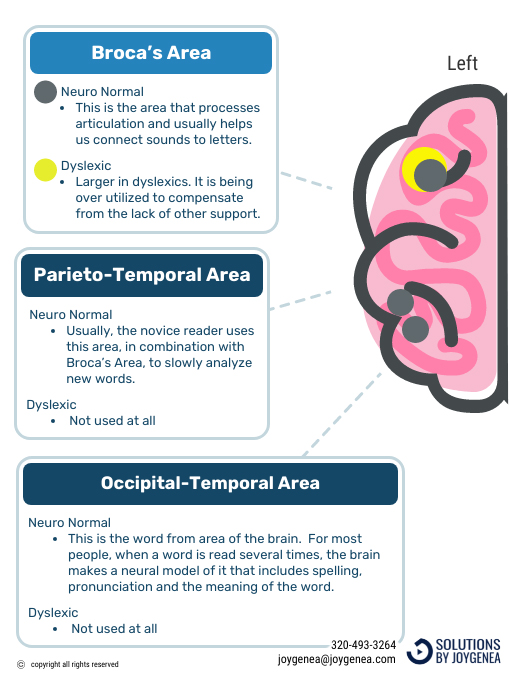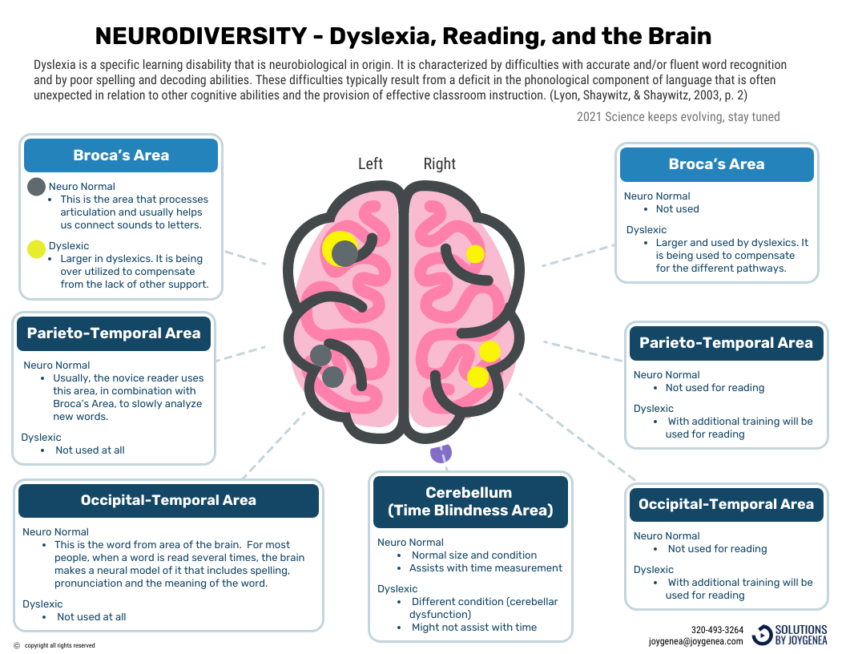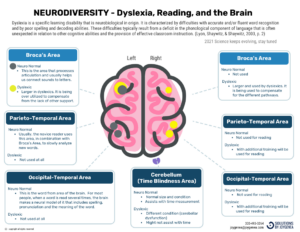“Everybody is a genius. But if you judge a fish by its ability to climb a tree, it will live its whole life believing that it is stupid.” ~Albert Einstein
After years of doing this work and finally having the science to help explain what most dyslexics have known for a long time, I am sharing this information with as many people as I can. Dyslexics don’t think like the majority of people and that can be harnessed as a superpower or wielded as a weapon against them. I have found this information about the brain to be valuable in understanding my process of thinking and also in understanding other people’s processing style. When I didn’t understand my brain, it allowed others to weaponize my differences as wrong, dumb and stupid. Empowerment starts with knowledge, so let’s take a journey through the dyslexic brain.
The journey starts with a little explanation of what Dyslexia is:
Dyslexia is a specific learning disability that is neurobiological in origin. It is characterized by difficulties with accurate and/or fluent word recognition and by poor spelling and decoding abilities. These difficulties typically result from a deficit in the phonological component of language that is often unexpected in relation to other cognitive abilities and the provision of effective classroom instruction. (Lyon, Shaywitz, & Shaywitz, 2003, p.2)
You also need to know a little about the left and right sides of the and each side’s key processing functions.
LEFT BRAIN FUNCTIONS:
- Analytic thought
- Logic
- Language
- Reasoning
- Science
- Math
- Writing
- Number skills
- Right-hand control
RIGHT BRAIN FUNCTIONS:
- Art awareness
- Creativity
- Imagination
- Intuition
- Insight
- Holistic thought
- Music awareness
- 3-D forms
- Left-hand control
Do you know how the typical dyslexic processes reading in their brain? There is a distinct neurobiological variation to the way people with dyslexia read.
Let me walk you through it by comparing it to the way a neuro normal brain would process it.
Everything starts on the left side of the brain when it comes to reading in the Broca’s Area in the front of the brain.

Broca’s Area – left side of brain
Neuro Normal Brain
This is the area that processes articulation and usually helps us connect sounds to letters.
Dyslexic Brain
Larger in dyslexics. It is being over utilized to compensate for the lack of other support.
Then information travels back to the
Parieto-Temporal Area – left side of brain
Neuro Normal Brain
Usually, the novice reader uses this area, in combination with Broca’s Area, to slowly analyze new words.
Dyslexic Brain
Not used at all
Then the brain processes the information working with the
Occipital-Temporal Area – left side of brain
Neuro Normal Brain
This is the word from an area of the brain. For most people, when a word is read several times, the brain makes a neural model of it that includes spelling, pronunciation, and the meaning of the word.
Dyslexic Brain
Not used at all
This ends our tour of the reading process in a neuro normal brain. Everything stays on the left side of the brain and is processed linearly.
Let’s continue our journey into how the dyslexic person learns to read and write.
Now we are going to travel over to the right side of the brain. To compensate for the fact that information doesn’t travel back to the Parieto-Temporal Area and Occipital-Temporal Area the right side of the brain builds all new neural pathways using the right side of the brain.

Broca’s Area – right side of brain
Neuro Normal Brain
Not used
Dyslexic Brain
Larger and used by dyslexics. It is being used to compensate for the different pathways needed to read and process writing.
Then information travels back to the
Parieto-Temporal Area – right side of brain
Neuro Normal Brain
Not used for reading
Dyslexic Brain
With additional training it will be used for reading
Then the brain processes the information working with the
Occipital-Temporal Area – right side of brain
Neuro Normal Brain
Not used for reading
Dyslexic Brain
With an additional training will be used for reading.
By understanding how information is processed through our neurology (our brain) we can better understand why it is important to have more diverse minds in a work environment. We can see why certain brains do certain work and we can also start to have conversations about how we all process a problem in different ways and come up with different solutions.
Each brain is different and that is why I encourage all of my clients to get as much testing as they can afford to understand their brain. When you can understand how you learn, what speed you process at and how you are best able to retain and remember information the whole world opens up in a new and more useful way. I watch people stop resisting learning, reading and writing. Instead, they start to explore it and find it to be an adventure. Having this knowledge allows you to better communicate what you need and to better explain why you might see things a certain way.
Understanding this explained why so many artists are dyslexic and scientists. They are storytellers and problem solvers who look at things differently than the neurotypical.
Why do you think so many neurodiverse people become entrepreneurs? Because they see solutions differently than most others and they are used to having to figure things out. They spent years trying to get through school and solve that problem, they are just taking that same skill and moving it into other areas of the world.
Now that you know more about the dyslexic brain and how it processes reading, make sure to share this with others, because knowledge is power.
JoyGenea Schumer
Business Owner, International Neurodiversity Coach and Speaker
If you would like to learn more about JoyGenea’s story-CLICK HERE
BONUS
You might have noticed a little spot on the bottom of the right side of the brain image that I did not talk about. That is the location of Time Blindness and if you want to read more about that you can check out my other stories about that.
Dyslexia and Time Blindness – What Is It
Story of a business owners time blindness
4 time blind people have meeting
Time Blindness and fighting with the clock being an employee

